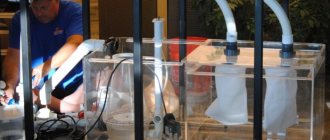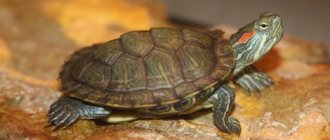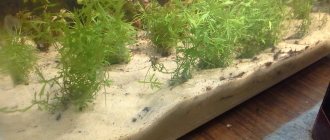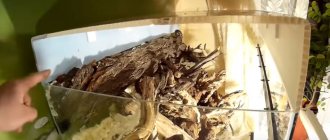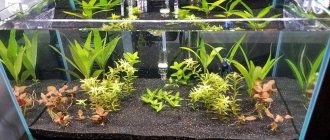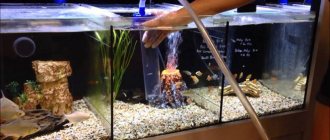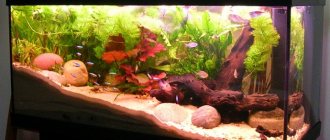Home › Aquarium equipment ›
( 5 ratings, average: 3.80 out of 5)
Many novice aquarists believe that choosing the best soil for an aquarium means choosing your favorite color of soil to make the aquarium beautiful. Actually this is not true. Of course, soil is an important decoration in an aquarium, thanks to which it becomes beautiful and attractive, but the health, beauty and behavior of aquarium fish, shrimp and living plants also depend on it. Therefore, it is very important to make the right choice, and for this you need to know several very important points.
Why do you need soil in a herbal aquarium?
An empty bottom looks unsightly in any type of aquarium.
A special bottom substrate adds aesthetic appeal to an indoor pond. However, in addition to being decorative, soil performs the function of a biobalance regulator. Certain types of plants can develop without a soil substrate:
Riccia
It is located close to the surface of the water, forming islands of greenery, so the quality of the soil is not important for it.
Anubias
Roots in driftwood, stones and various decorative elements.
Elodea
Feels great in pebbles and sand.
However, for plants with a developed root system, soil is vital. The aquarium flora receives the main amount of nutrients from it.
Substrate laid on the bottom:
- promotes the appearance of bryozoans, fungi, bacteria and other microorganisms necessary for underwater inhabitants;
- recycles fish waste;
- filters water, trapping harmful suspended matter and microparticles that pollute it.
Soil is a complex biosystem that serves as the basis of the nitrogen cycle. If this is not a really large fraction, but a fairly common 1-2-3-4 mm, then the total surface area on which nitrifying bacteria settle is several times larger than the area on aquarium filter fillers.
Thanks to the natural processes of siltation, anaerobic zones are also formed in the aquarium substrate - the basis for denitrification. The biobalance of the entire aquarium depends on the “health” of the soil.
How to calculate the amount of substrate
There are two parameters that you need to rely on to understand how much soil is needed in the aquarium. This is the type of reservoir and its volume .
For a tank with a small amount of algae, 2-3 cm will be enough; for a herbalist, a more substantial layer will be required - 10 centimeters.
Professionals usually use the formula m = h*b*a*1.5/1000 for calculations, where
- m—bottom mass in kg;
- h is the height of the container;
- b is its width;
- a is the length.
Types of aquarium soil
Based on type and structure, all aquarium soils are divided into several categories based on composition and characteristics.
Natural
Sand
Peat
Gravel
Rocks
Lava
These are natural materials: sand, peat, gravel, rocks, lava. This type of substrate is empty (or bare), without nutrients. When planted in it, plants receive nutrition only from fertilizers, so you should not expect their vigorous growth.
Natural soil is highly decorative and low cost. But this is not the best option for keeping herbalists.
Advantages of natural substrates:
- ensuring circulation and water purification effect;
- neutral effect on the pH reaction of the aquatic environment;
- ease of care;
- the ability to create beautiful three-dimensional compositions that look good from the outside;
- performance of biological function “excellent”.
The downside is the complete lack of nutritional components.
Machined (mechanical)
1- Coral sand 2- Glass soil
A type of natural soil. It also refers to empty substrates and, when used in an herbalist, involves the use of a large amount of fertilizers or hydrobionts - organisms that produce food for plants. You can accelerate the growth of aquatic plants on such soil by adding root fertilizers.
The disadvantage of this variety is low strength. When particles break down, water becomes polluted.
The category of “treated” soils also includes colored dolomite, coral sand and glass. They have no advantages over natural stones, although they look quite beautiful.
Natural plus deposit
Many manufacturers offer special mixtures designed to combine with natural soils (usually crushed quartz). The deposit is used as a substrate.
To create a multilayer substrate, you can take soil and substrates intended for terrestrial plants. However, this creates a danger of disturbing the biobalance in the aquarium.
When choosing a substrate, you should pay attention to the elements included in the composition. After all, these nutrients will be released into the water. From some manufacturers you will receive exclusively microelements and iron, from others - complete nutrition with all the necessary components. TetraPlant Complete Substrate or similar substrates with a full set of plant essentials can be considered optimal.
A worthy alternative to branded natural soil nutrient compositions is the use of vermicompost and a mixture of high-moor and low-lying peat from a garden store.
Nutritious
This type of aquarium soil is called Soil, and it was originally developed in Japan for keeping shrimp. Later, the ADA company began producing nutrient soils. Their product formula has been improved to use Soyl for growing aquatic plants.
Aquarists use this type of soil to lay herbal and shrimp tanks on the bottom, as well as to combine these types of home reservoirs. Soil is essentially natural fertile soil combined with clay baked in a rotary kiln.
The starting material forms granules of identical size and color. This variety usually includes all substrates that are not gravel. Aqua-soil has a loose, fluffy structure. The root system of plants in such conditions feels as comfortable as possible and develops successfully.
Additionally, aqua-soil reduces the acidity and hardness of water. Unlike natural soil, such nutrient mixtures are tested in laboratories, so they do not have a negative impact on the water balance of the aquarium. At the same time, they contain a sufficient supply of nutrients for the proper development of plants.
One of the advantages of Soyl is its ability to retain phosphates. This is achieved due to high CEC in combination with a high content of organic acids.
The safety of the soil is checked by the “vinegar test”. Take a handful of soil and fill it with acetic acid (70%). If there is no hissing, then the soil can be used in an aquarium. If the substrate hisses, it is better not to take risks, especially if you do not have the opportunity to replace water with distillate or osmosis.
DIY substrate
You can prepare the substrate for decorating the bottom yourself. To do this, the selected materials are laid in layers.
Clay
The clay substrate is a source of microelements for the flora.
Peat
It is better to choose pressed or granular peat substrate. In its natural form, peat can lead to acidification of the substrate.
Coconut fiber
An excellent aquarium filler with high filtering capacity.
Sorbent
Vermiculite is a nutrient substrate; it perfectly retains microelements and promotes the development of the root system of plants.
Coal
An excellent natural filter with high adsorbing capacity.
Pebbles
The stones become a press for the lighter layers of the substrate and create support for the plants.
Basalt
Basalt chips are an excellent finishing layer. It has a smooth black color.
The advantages of this finish include a large selection of crumb sizes and its availability.
Soil selection criteria
The substrate placed on the bottom of the herbal aquarium should help create conditions in the aquatic environment that are closest to natural ones. Soil is the basis for plant rooting and a habitat for fish and other inhabitants of the aquarium. It must meet a number of requirements. Otherwise, beneficial bacteria will not be able to develop inside the aquarium, decomposing food residues and waste products of the aquarium inhabitants into mineral substances useful for plants.
To ensure and maintain optimal biobalance in the aquarium, the soil must have the following characteristics:
- Increased porosity. Having free space between particles is necessary for the growth of beneficial bacteria.
- The size of the fractions is from 3 to 5 mm.
- No foreign matter or stones.
- Uniform and sufficient roundness. Fractions with sharp corners quickly cake and injure the bodies of the aquarium inhabitants.
- Inert indicators of chemical substances content.
- Sufficient nutrient content.
It is not permissible to use excessively light soil in a herbal aquarium. The optimal compositions are made from 3 types of filler: granite, quartz and basalt. In them, plants take root better and absorb nutrients for rapid growth. All other breeds are difficult to siphon.
An important selection criterion is the type of specific ecosystem and type of vegetation. Plants have different substrate requirements. For example, the soil may be intended for ground cover plants (hemianthus, eliocharis, glossostima) and be unsuitable for large species (echinodorus, cryptocarines).
Is Soil always needed in a herbalist?
Nutrient soil is a tool with which you can correctly or incorrectly organize the maintenance of a herbal aquarium. The cost of soyl is quite high, and its use is not always 100% justified.
Let's try to understand the features of using this type of soil:
- Soil is necessary if you plan a dense herbal garden with a predominance of plants planted in the ground. If you plan to create moss grass, mountain cascades from hemianthus, Monte Carla, Yu Soil is absolutely not needed. In this case, the plants in the water must take nutrition from the water, and the soil will absorb part of the water and buffer it in the soil.
- When choosing a Soil, carefully read the recommendations on the packaging and, most importantly, follow the aquarium startup plan. Nutritious, expensive soil does not always guarantee success. Each aquarium is individual and the water flowing from the tap is different for everyone. Lighting conditions and the selection of plants also differ. Therefore, the soil successfully used by someone does not at all guarantee a successful outcome for everyone. Some parameters of water hardness lead to the disintegration of even high-quality soil from a cool manufacturer into dust. While other substrates work quite well.
- Take into account the charge level of the soil, since substrates differ in this indicator. Do not rely on forum chatter - “this is a weak soil, and this one is strong...”. Read the instructions and ingredients. Choose those that are needed for your project. It doesn't have to be super-concentrated Soyl. It is better to take a composition with a high content of microelements. And add the macro yourself.
Care
The soil mixture does not require frequent maintenance and only requires periodic cleaning. To care for the aquarium and clean the soil, you will need an aquarium siphon - a special tool that uses a vacuum to suck out excess particles from the substrate. Thorough cleaning occurs if the soil is chosen correctly and its water permeability is maintained. Aquarium filters are good at keeping the top layers of soil clean.
A complete replacement of the substrate is carried out once every 5 years. There is no need to clean the mixture in the first year. If plants are planted, the bottom is fed with fertilizers and minerals.
Some fish are able to live without any soil mixture at all, but this leads to a stressful state for many fish. Creeping plants, such as Echinodorus, are used as replacements.
Review of popular brands
Most world-famous brands have switched to the production of specialized nutrient soils for herbalists.
Many brands of aquarium substrates have been tested by users, so we can present a rating of the best compositions:
Prodibio AquaGrowth Soil and AquaShrimp Powder
Prodibio is a French brand that has earned a lot of positive reviews from aquascapers in Russia and other countries. The difference between the two brands of this manufacturer is the size of the fractions - from 1 to 3 mm - the first, from 0.6 to 1.2 mm - the second. The soils are densely charged with microelements. The composition has been carefully analyzed for harmful impurities.
Gloxy Soil
A mixture of domestic production from the company Aqua Logo. There are no customer reviews for this soil yet, but in terms of composition and price, the option is quite acceptable. The substrate is made from natural, pre-heat-treated raw materials. Quickly creates ideal conditions for the growth of aquatic plants. Contains special colloids that clarify and filter water. Stabilizes the acidity level of water. The granules are durable and retain their shape for a long time, which prevents rapid caking of the soil.
JBL Manado
It is not a nutrient soil, but is recommended for aquariums by plants due to the high porosity of the granules and the ability to store fertilizers, releasing them as needed. Particle sizes are 0.5-2 mm. The material is clay. The soil has one drawback: it is very light, which can cause plants with poorly strengthened root systems to float to the surface, especially when keeping burrowing fish in the aquarium.
Dennerle shrimp king active soil
Produced from carefully selected natural soils that provide plants with essential minerals and trace elements. The main component is irregularly shaped earth grains with a diameter of 1 to 4 mm. They give the aquarium a natural look. The soil does not promote the growth of algae and does not color the water. The porous surface is ideal for bacterial growth.
Dennerle scaper s soil
Nutrient substrate with a high content of micro- and macroelements. The basis of the mixture is volcanic andozol. The soil filters water, stabilizes its acidity, and removes hardness. Special components prevent algae from growing in the aquarium.
Dennerle DeponitMix
Nutrient mixture for herbalists, which is recommended to be used as a substrate. The basis is neutral quartz sand, the nutritional components are peat, soil and clay. To give plants a bright green color, chelated iron compounds are added to the mixture. Porous granules filter water well and are actively populated by bacteria.
ADA Power Sand Special
ADA is a leading manufacturer of aquarium soils. This brand is used as a substrate. It contains nutrient granules made of porous volcanic stone and special additives that ensure rapid colonization of the bottom by bacteria.
Any ready-made mixture for an aquarium is intended for use for up to 3 years. Then it must be changed.
What soil should not be used?
There are a number of substrates that cannot be placed on the bottom of the herbalist. These include:
- Natural chemically active soil . Despite its natural origin, such a substrate negatively affects water parameters and makes it impossible to maintain biobalance in the aquarium. Examples of chemically active soils are marble chips, coral sand, limestone, neutral soil with additional inclusions.
- Painted primer . Brightly colored granules often release toxic substances that spoil the water. They are dangerous for plants and all aquatic organisms. These may be carbonates that increase water hardness. Painted elements cause acidification of the soil or the formation of hydrogen sulfide as a result of anaerobic processes. In this case, we say that the soil is “phonic” with carbonates. The substrate can be contaminated with organic matter, ammonia, nitrates, and chemical compounds.
- Glass granules . A chemically neutral substrate, but its use in planted aquariums is unacceptable. The smooth surface of the glass does not allow nutrients and plant roots to be retained.
A normal ecosystem in an aquarium is impossible without high-quality soil that meets all requirements. When selecting a specific option, it is important to take into account the species of plants, fish and other inhabitants, the characteristics of their life activity and biological requirements.
Correct styling
The placement of soil is always oriented towards the planting points. Spreading a nutrient substrate over the entire bottom area is not always justified: sometimes pinpoint islands in places where flora accumulates are enough.
The rest of the space is covered with a neutral substrate. is encouraged - this creates additional zoning and accentuates decorative elements .
However, the substrate must be treated before installation. How to prepare the soil for laying? It needs to be disinfected (especially for homemade substrate).
To destroy bacteria, heat treatment is suitable: the substrate is heated in the oven for 20–40 minutes at a temperature of at least 200 ° C and allowed to cool naturally.
How to treat the soil before adding it directly to the aquarium? Rinse to remove dust.

